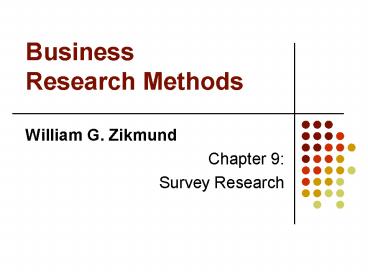Business Research Methods William G' Zikmund - PowerPoint PPT Presentation
1 / 32
Title:
Business Research Methods William G' Zikmund
Description:
The Annenberg Public Policy Center Survey, 1999. 1,102 parents in ... 49%: might interfere with parents' ability to teach ... the Gallup Poll. Consumer ... – PowerPoint PPT presentation
Number of Views:101
Avg rating:3.0/5.0
Title: Business Research Methods William G' Zikmund
1
BusinessResearch MethodsWilliam G. Zikmund
- Chapter 9
- Survey Research
2
The Annenberg Public Policy Center Survey, 1999
- 1,102 parents in computer households
- 78 give away personal information on the
Internet - 78 view sexually explicit material
- 64 might become isolated
- 49 might interfere with parents ability to
teach values and beliefs - 42 develop anti-social behavior
- Most parents believe that the Internet is an
essential tool with positive potential - 32 parents using filtering software
3
SURVEYS
- A method of gathering primary data based on
communication with a representative sample of
individuals using verbal or written questioning. - Most survey research is descriptive research.
- May be quantitative or qualitative.
4
RESPONDENTS
- Respondents are a representative sample of people
5
Gathering Information Via Surveys
- Quick
- Inexpensive
- Efficient
- Accurate
- Flexible
6
PROBLEMS
- Poor design
- Improper execution
- Samples are biased
- Questions are poorly phrased
- Interviewers are not properly instructed and
supervised - Results are misinterpreted
7
Tree Diagram of Total Survey Error
Random sampling error
Total error
Systematic error (bias)
8
Random Sampling Error
- The difference between the result of a sample and
the result of a census conducted using identical
procedures. - A statistical fluctuation that occurs because of
chance variation in the elements selected for the
sample.
9
Systematic Error(Nonsampling errors)
- Systematic error results from some imperfect
aspect of the research design or from a mistake
in the execution of the research.
10
Sample Bias
- Sample bias - when the results of a sample show a
persistent tendency to deviate in one direction
from the true value of the population parameter.
11
Tree Diagram of Total Survey Error
Administrative error
Systematic error (bias)
Respondent error
12
Tree Diagram of Total Survey Error
Nonresponse error
Respondent error
Response bias
13
Respondent Error
- A classification of sample bias resulting from
some respondent action or inaction - Nonresponse bias
- Response bias
14
Nonresponse Error
- The statistical difference between a survey that
includes only those who responded and a perfect
survey that would also include those who failed
to respond. - Nonrespondents
- people who refuse to cooperate
- Not-at-homes
- Self-selection bias
- Over-represents extreme positions
- Under-represents indifference
15
Response Bias
- A bias that occurs when respondents tend to
answer questions with a certain slant that
consciously or unconsciously misrepresents the
truth.
Low-income Mexican Americans no consumption of
beer Low-income White Americans misrepresents
the quantity Middle-income White Americans
All groups overreported the purchases of products
with Positive Connotations, such as milk.
16
Tree Diagram of Total Survey Error
Acquiescence bias
Extremity bias
Deliberate falsification
Response bias
Interviewer bias
Unconscious Misrepresen- tation
Auspices bias
Social desirability bias
17
Deliberate Falsification
Why?
- To appear intelligent
- To conceal personal information
- To avoid embarrassment
- Responses may not be confidential
- Become bored
- To please the interviewer
- Average man effects
- Savings account balances, number of hours worked,
voting behavior..
18
Unconscious Misrepresentation
Why?
- Misunderstand the question
- Question format, question content
- Time lapse (forgot the details)
- little thought
- Cannot adequately express their feelings in words
Do you use toothpaste?
Few responded positively
Positive response rate roared
Do you use Colgate?
In Philippines
19
Acquiescence bias
- A category of response bias that results because
some individuals tend to agree with all questions
or to concur with a particular position. - New products, new programs, or ideas previously
unfamiliar to the respondents
20
Extremity bias
- A category of response bias that results because
response styles vary from person to person some
individuals tend to use extremes when responding
to questions.
21
Interviewer bias
- A response bias that occurs because the presence
of the interviewer influences answers. - Socially acceptable responses will be provided
- Interviewers face expressions
22
Auspices bias
- Bias in the responses of subjects caused by the
respondents being influenced by the organization
conducting the study.
23
Social desirability bias
- Bias in responses caused by respondents desire,
either conscious or unconscious, to gain prestige
or appear in a different social role. - Ex Did you vote in the last election?
- What is your salary?
- Have you ever been fired from a job?
24
Tree Diagram of Total Survey Error
Administrative error
Systematic error (bias)
Respondent error
25
ADMINISTRATIVE ERROR
- Improper administration or execution of the
research task
26
Tree Diagram of Total Survey Error
Data processing error
Sample selection error
Interviewer error
Interviewer cheating
27
Administrative error
- Interviewer cheating - filling in fake answers or
falsifying interviewers. - Data processing error - incorrect data entry,
computer programming, or other procedural errors
during the analysis stage. - Sample selection error -improper sample design or
sampling procedure execution. - Interviewer error - field mistakes.
28
29
TIME PERIOD FOR SURVEYS
- CROSS-SECTIONAL
- LONGITUDINAL
30
Cross-sectional study
- A study in which various segments of a population
are sampled. - Data are collected at a single moment in time.
31
Longitudinal study
- A survey of respondents at different times, thus
allowing analysis of changes over time. - Tracking study - compare trends and identify
changes - consumer satisfaction
- Example the Gallup Poll
32
Consumer Panel
- A longitudinal survey of the same sample of
individuals or households to record (in a diary)
their attitudes, behavior, or purchasing habits
over time. - Example brand-switching behavior
- Often expensive to conduct































